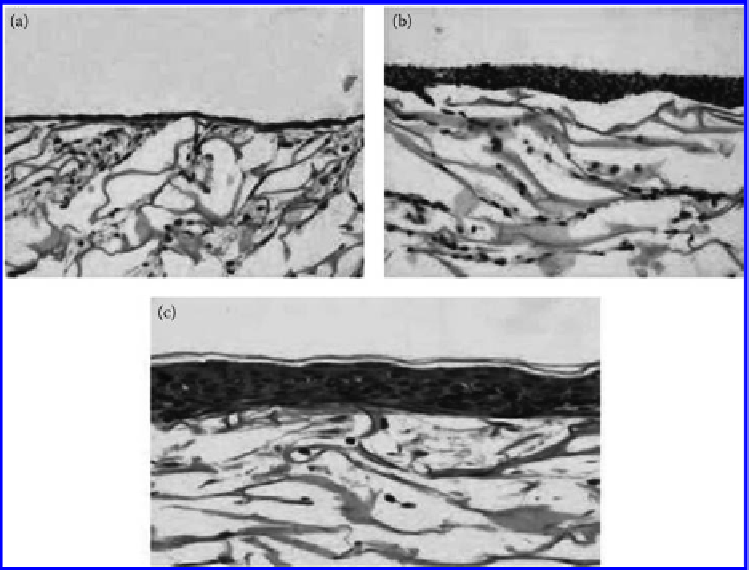Biomedical Engineering Reference
In-Depth Information
Figure 9.23
Histological appearance of fibroblasts and keratinocytes cocultured in chitosan-gelatin-HA scaffolds for (a) 1
week, and cocultured at an air-liquid interface for (b) 1 week and (c) 2 weeks (H&E;original magnification ×200).
(From Liu, H. F., Yin, Y. J., and Yao, K. D. 2007.
J Biomater Appl
21: 413-430. With permission.)
9.5.3 Cartilage
Articular cartilage is a unique connective tissue in the human body because blood vessels
and nerves are absent in the tissue. Cartilage also contains large amounts of ECMs. Except
for water, the main constituents of the ECMs in hyaline cartilage are proteoglycans and
collagens [122]. Cartilage is an essential tissue for normal joint functions such as cushion-
ing and lubrication. Articular cartilage, dense white specialized connective tissue cover-
ing the articulating surfaces of bone, contains chondrocytes and ECM. Once damaged,
articular cartilage has very little capacity for spontaneous healing because of the avascular
nature of the tissue. An initial surgical attempt to restore the normal articulating sur-
face of joint cartilage was made with the introduction of Pridie's resurfacing technique
[123]. Current therapies include abrasion arthroplasty, subchondral drilling, prosthetic
joint replacement, and ultimately, transplantation of autologous chondrocytes or tissues.
However, these treatments do not constitute a complete recovery for the patient and, in
most cases, persistent problems of donor site morbidity, limitations of patient mobility and
consequent disability, loss of implants, and limited durability of the prosthetics are
observed. Thus, the novel cartilage tissue-engineering approach has attracted special
attention. Tissue engineering of articular cartilage involves the isolation of articular chon-
drocytes or their precursor cells that may be expanded
in vitro
and then seeded into a
biocompatible matrix, or scaffold, for cultivation and subsequent implantation into the
joint. The choice of biomaterial is very critical for the success of tissue-engineering

Search WWH ::

Custom Search